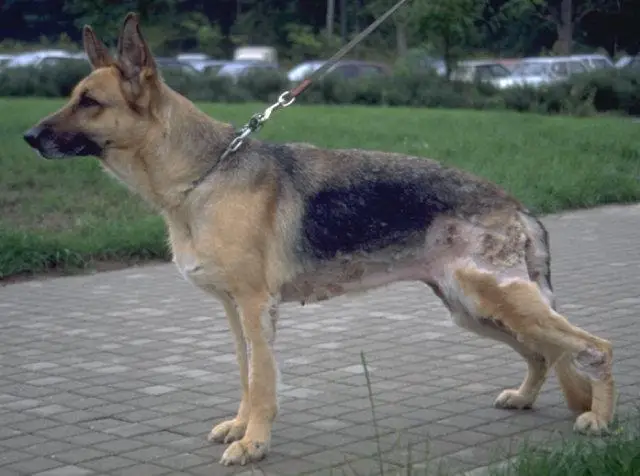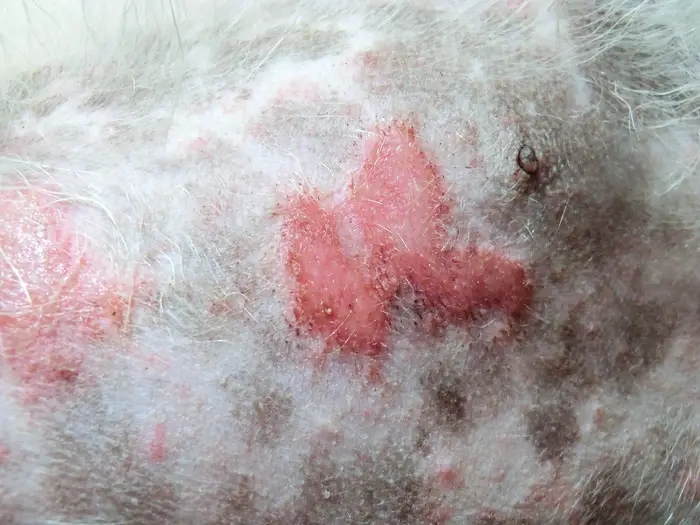Pyoderma in dogs is simply pus on the skin caused by bacterial infection, inflammation, or skin cancers. Small nodules on the skin surface characterize the disease, and the nodule is filled up with purulent materials. The most common signs are severe itching, hair loss, skin redness, restlessness, and rough hair coats.
Importance of Pyoderma in Dogs
Pyoderma is the most common bacterial disease on a dog’s skin. The dog’s skin is thinner and has lower pH, which increases the probability of bacterial infection. Damage to the standard skin structure also increases the chance of skin diseases. Allergic reactions due to food or pollen grain also increase the probability of pyoderma in dogs.

Causes of Pyoderma in Dogs
The causes of pyoderma in dogs are many, like bacterial, fungal, allergic, inflammation, or skin cancer.
- The most common bacteria are Staphylococcus pseudntermedius, Staphylococcus aureus, E Coli, Pseudomonas spp, and Actinomyces spp.
- Break the continuity of skin that increases the chance of bacterial invasion.
- A recurrent bacterial infection that fails to treat.
- Use of glucocorticoid as treatment.
- Cushing’s disease.
- Sarcoptes or demodectic manges.
- Immunosuppression or immune disorders of dogs.

Risk Factors of Canine Pyoderma
The risk factors or predisposing factors of pyoderma are as follows:
- Poor grooming of dogs.
- The skin fold of certain dog breeds enhances the probability of skin diseases.
- Certain areas of a dog’s skin like lip folds, groin region, under the tail, mammary gland, and neck folds are the most common region for pyoderma.
- Certain dog breeds like Spaniel, Pugs, Boxer, Pekingese, and Bulldogs are more prone to skin diseases.
- Warm or moist environment.

Clinical Signs of Canine Pyoderma
Pyoderma in dogs is the most common skin disease. The disease is manifested by:
- Excessive scaling in the skin.
- Blood or pus in the skin.
- Excessive crusting.
- Foul smell in the lesion.
- Loss of hair.
- Presence of rush in the skin.
- Severe itching.
- Redness of the skin.
- Swelling around the rush or crush.
- Bald patches around the hair.
- Presence of yellow papules.
- Ulcerated skin.

Diagnosis of Pyoderma in Dogs
The diagnosis of canine pyoderma can be made by:
- Clinical history of breeds, predisposing or risk factors.
- Specific clinical signs.
- Bacterial or fungal culture of a skin scraping.
- Allergic test of the dog’s skin.
- Skin Cytology.
- Skin Biopsy.
- Complete Blood Count (CBC).
- Allergic skin test.
Treatment of Canine Pyoderma
The treatment of canine pyoderma needs careful diagnosis of the underlying causes of the disease. The length of treatment depends on the severity of the disease. The general line of treatment for pyoderma is:
- Antibiotics should be given both parenterally and locally over the lesions.
- Anti-allergic or antihistamines drugs.
- Antifungal or anti-bacterial shampoo.
- You can use medicated spray or ointment over the affected skin.
Prevention of Pyoderma in Dogs
The following measures can prevent the disease:
- Regular grooming of dogs at least twice daily.
- Reduce the food containing allergens.
- You can use an Epsom salt foot bath to prevent infection.
The Final Talk on Pyoderma in Dogs
Pyoderma is a common skin disease of dogs with poor hygiene. The disease is characterized by pus in skin lesions, itching, alopecia, and loss of condition. The disease is curable after adequate treatment. In my article, I have highlighted almost all the information that will help you to keep your dog healthy. Thank you for being so patient in reading.